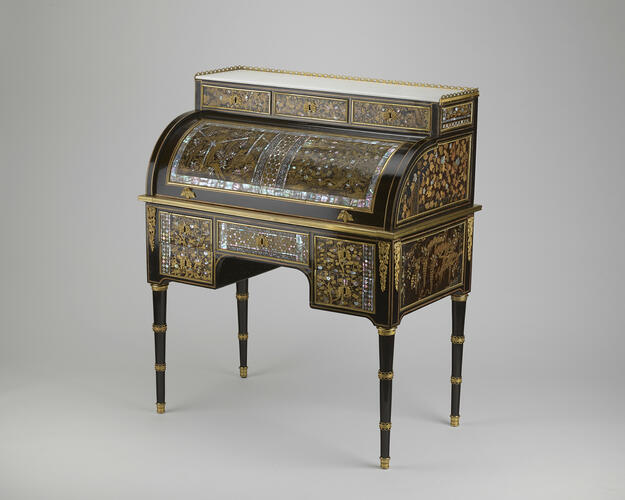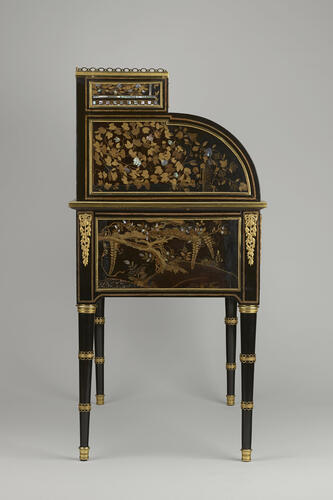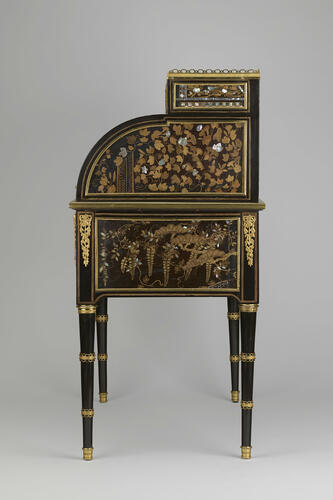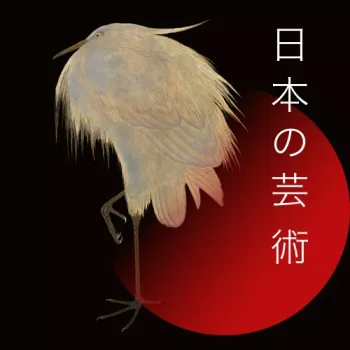Desk 1580 - 1790
Wood, black lacquer, gold and silver lacquer, mother of pearl, leather, gilt metal mounts | 110.5 x 95.5 x 55.4 cm (whole object) | RCIN 31187
-
Cylinder desk with frieze drawers and marble top. The desk incorporates in total thirteen sections of Japanese lacquer, depicting lions, birds, flowers and foliage, inlaid with mother of pearl. The cylinder encloses open compartments and drawers veneered with tulipwood, and a pull out writing surface with tooled leather. Five drawers in the apron and three in the frieze, all with gilt metal escutcheons. Two lacquer panels on each side. Turned tapering legs mounted with gilt metal borders and feet.
In the eighteenth century, Japanese export lacquer remained highly luxurious, but the shapes of the old coffers and cabinets incorporating it were considered unfashionable. This led Parisian marchand-merciers, sellers of furniture and objets d’art, to supply cabinetmakers (ébénistes) with old lacquer that could be cut up and incorporated into entirely new pieces of furniture. This French bureau à cylindre (roll-top desk) is an example of the practice.The ebonised oak and mahogany bureau is inlaid with nanban-style lacquer of the Momoyama period (1573–1615). Good quality early lacquer like this was rare in the eighteenth century. The lacquer used here probably originally came from the domed lid of a large coffer. This is confirmed by the fact that the underside of the roll-top is decorated with plants which cannot readily be seen in either the open or closed position, but which would have been visible on a coffer when the domed lid was opened. The curve of the coffer lid meant it could be incorporated into the roll-top without the need to steam and bend the fragile lacquer.
Further remnants of lacquer from the original domed coffer can possibly be identified on another bureau, formerly in the collections of the Comtesse du Pont de Gault and latterly Luigi Anton Laura. That desk is of the same shape and size, and has almost identical mounts. Even the japanning on the back of each bureau seems to be by the same hand. The two desks were almost certainly made by the same cabinetmaker, or workshop, at roughly the same time. They may have been ordered as a ‘pair’, but it is not impossible that the ébéniste made a second desk with some of the lacquer that remained after the first one had been made.
Furniture such as this, from important French collections, entered the market after the French Revolution and could be bought by English collectors at heavily reduced prices. This is how George IV, when Prince of Wales, was eventually able to purchase this bureau for Carlton House at Mr Philips’s sale in 1802.
Text adapted from Japan: Courts and Culture (2020)Provenance
The desk was purchased by George IV, when Prince of Wales in 1802, at Mr Phillips's sale, no.473, for £68 5s (RA 25269), where it was described as a 'Ladies Cylinder Secretaire'. It was sent to Vulliamy's on 3 August 1810 to be cleaned (Jutsham Deliveries I, p.68) and sent from Carlton House to Brighton Pavilion on 23 October 1820 (Jutsham Deliveries II, p.1).
-
Creator(s)
(nationality)(nationality)Acquirer(s)
-
Medium and techniques
Wood, black lacquer, gold and silver lacquer, mother of pearl, leather, gilt metal mounts
Measurements
110.5 x 95.5 x 55.4 cm (whole object)
Alternative title(s)
Bureau à Cylindre













